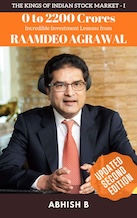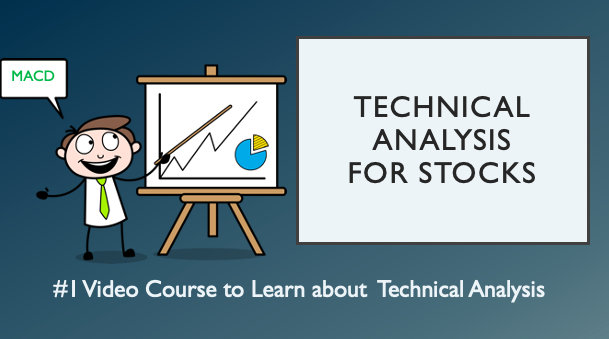Book Summary of 0 to 2200 Crores
by Ashish B

What is the book about?
The book "0 to 2200 Crores: Incredible Investment Lessons from Raamdeo Agrawal" focuses on the life and investment journey of Raamdeo Agrawal, a prominent Indian stock market investor and co-founder of Motilal Oswal Financial Services Limited. The book provides insights into Agrawal's rise from a humble background to creating a substantial fortune in the Indian stock market. It covers his investment strategies, particularly his QGLP (Quality, Growth, Longevity, Price) framework, and offers lessons on wealth creation through long-term investing. The book is part of a series that aims to share the stories and lessons of top Indian stock market investors.
Who should read the book?
This book is ideal for:
- Beginner Investors: Those new to the stock market will find the practical tips and foundational lessons valuable.
- Experienced Investors: Seasoned investors can gain insights into Agrawal's unique investment strategies and philosophies.
- Finance Enthusiasts: Anyone interested in the Indian stock market, wealth creation, and the journey of a successful investor would benefit from reading this book.
- Students of Finance: Those studying finance or business will find useful case studies and real-world applications of investment principles.
10 Big Ideas from the Book
- The Importance of a Strong Investment Philosophy: Developing a clear and effective investment strategy is crucial for success in the stock market.
- QGLP Framework: Focus on Quality, Growth, Longevity, and Price when selecting stocks for long-term investment.
- The Power of Compounding: Patience in the stock market allows the power of compounding to create significant wealth over time.
- Market Cycles: Understand that the stock market does not grow in a straight line; it has cycles of growth and decline.
- Investing vs. Speculating: True investing is based on thorough research and analysis, while speculation is driven by short-term price movements.
- Value vs. Price: Always differentiate between the price of a stock and its underlying value; focus on acquiring stocks that are undervalued.
- Focused Portfolio Approach: Avoid over-diversification; instead, concentrate on a few high-quality stocks.
- Don't Time the Market: It's impossible to accurately predict market movements; focus on buying and holding good companies.
- Continuous Learning: Reading and staying informed are essential for making sound investment decisions.
- Think Big: Have ambitious goals and believe in the potential of the stock market to achieve substantial financial growth.
Summary of "0 to 2200 Crores: Incredible Investment Lessons from Raamdeo Agrawal"
Overview
The book "0 to 2200 Crores" chronicles the life and investment journey of Raamdeo Agrawal, one of India’s most successful investors and co-founder of Motilal Oswal Financial Services Limited. The book is a blend of biography, investment strategy, and financial wisdom. It traces Agrawal's humble beginnings, his rise in the Indian stock market, and the development of his unique investment philosophy. Central to the book is the QGLP (Quality, Growth, Longevity, and Price) framework, which Agrawal developed and which has been pivotal in his success.
Key Insights
-
The Journey from Humble Beginnings to Success:
- Raamdeo Agrawal was born into a lower-income farming family in Raipur, Chhattisgarh. His early life was marked by financial struggles, but his father emphasized the importance of education.
- Agrawal moved to Bombay (Mumbai) to become a Chartered Accountant, which was a turning point in his life. His interest in the stock market was piqued during his studies, leading him to pursue a career in finance.
-
Early Challenges and Learning:
- Agrawal’s initial years in the stock market were challenging, marked by limited capital and tough market conditions.
- His first significant learning came during the 1993 stock market crash, which taught him the volatility of markets and the importance of having a solid investment philosophy.
-
The Development of the QGLP Framework:
- QGLP stands for Quality, Growth, Longevity, and Price. This framework is a systematic approach to selecting stocks that have the potential to be multi-baggers (stocks that can multiply in value many times over).
- Quality: Focuses on the stability and competitive advantage of a business.
- Growth: Looks at the company’s potential to increase earnings and return on equity.
- Longevity: Evaluates the company’s ability to sustain its competitive advantage over the long term.
- Price: Ensures that the stock is purchased at a reasonable price relative to its intrinsic value.
- QGLP stands for Quality, Growth, Longevity, and Price. This framework is a systematic approach to selecting stocks that have the potential to be multi-baggers (stocks that can multiply in value many times over).
-
Learning from Warren Buffett:
- Agrawal was profoundly influenced by Warren Buffett, whom he regards as his mentor. After attending Berkshire Hathaway’s annual meetings, Agrawal adopted many of Buffett’s principles, particularly the focus on intrinsic value and the importance of a long-term perspective.
-
The Importance of Patience and Compounding:
- Agrawal emphasizes the power of compounding, which requires patience and a long-term investment horizon. He argues that true wealth in the stock market is built over decades, not years.
-
Market Cycles and Emotional Resilience:
- The book discusses the cyclical nature of the stock market and the importance of maintaining emotional resilience during market downturns. Agrawal highlights that most investors lose money by reacting emotionally rather than sticking to their long-term investment plans.
-
Focused Portfolio Approach:
- Agrawal advises against over-diversification. Instead, he advocates for a focused portfolio of high-quality stocks, allowing investors to concentrate on their best ideas and maximize returns.
-
The Role of Continuous Learning:
- The book stresses the importance of continuous learning and staying updated with market trends, business strategies, and new investment opportunities. Reading and research are essential to developing a deep understanding of businesses and making informed investment decisions.
-
Think Big and Be Ambitious:
- Agrawal encourages investors to think big and have ambitious financial goals. He believes that the Indian stock market has immense potential for growth, and with the right approach, investors can achieve significant wealth.
-
Five Tips for Beginners:
- Be willing to pay the tuition fee: Accept that losses are part of the learning process.
- Build a strong knowledge foundation: Education is crucial for making informed decisions.
- Develop emotional resilience: Don’t let market fluctuations dictate your investment strategy.
- Plan for the long term: The stock market rewards patience.
- Seek professional help if needed: If you lack the time or expertise, consider professional management.
Relevant Metrics and Key Concepts
-
QGLP Framework:
- Quality: Stability, competitive advantage, and integrity of management. Look for businesses with a strong consumer base and a sustainable competitive edge.
- Growth: Analyze earnings growth, Return on Equity (ROE), and the company’s ability to reinvest profits at a high return. Target companies with ROE above 20%.
- Longevity: The business’s ability to sustain growth over decades. Look for industries with long-term relevance and companies that innovate to maintain their competitive position.
- Price: Invest in stocks that are undervalued relative to their intrinsic value. Use metrics like the Price-to-Earnings Growth (PEG) ratio to assess whether the stock is reasonably priced.
-
Power of Compounding:
- Compounding is described as the process where the value of an investment increases because the earnings on an investment, both capital gains, and interest, earn interest as time passes. The longer the investment period, the greater the power of compounding.
-
Market Cycles:
- Understand that markets move in cycles and that both booms and busts are inevitable. Successful investors stay calm during downturns and use them as opportunities to buy quality stocks at a discount.
-
Focused Portfolio:
- Avoid spreading investments too thin. A concentrated portfolio allows investors to focus on their best investment ideas and thoroughly understand the businesses they own.
-
Valuation Techniques:
- Use intrinsic value calculation to determine whether a stock is under or overvalued. This involves estimating the present value of a company’s future cash flows and comparing it to the current market price.
-
Patience and Long-Term Investing:
- Significant wealth creation happens over decades, not years. Patience is key to allowing investments to grow and compound.
-
Behavioral Discipline:
- Investors should maintain discipline and stick to their strategy, avoiding emotional decisions driven by market noise.
Significance
- QGLP Framework: Provides a structured approach to identifying multi-bagger stocks, emphasizing the importance of quality and growth at a reasonable price.
- Compounding: Reinforces the idea that long-term patience can lead to exponential growth in wealth.
- Market Cycles: Teaches the importance of emotional stability and resilience during market downturns.
- Focused Portfolio: Encourages deeper knowledge and better returns by concentrating investments in fewer high-quality stocks.
- Valuation Techniques: Highlights the importance of understanding the true value of a company, beyond just its market price.
This summary and the key insights provided offer a roadmap for investors to approach the stock market with a long-term, disciplined, and informed mindset, much like Raamdeo Agrawal did throughout his successful investment journey.
Which Other Books are Used as Reference?
The book references several key texts that have influenced Raamdeo Agrawal's investment approach, including:
- "The Snowball: Warren Buffett and the Business of Life" by Alice Schroeder - A biography of Warren Buffett.
- "Berkshire Hathaway Letters to Shareholders" by Warren Buffett - A compilation of Buffett's letters to shareholders, offering insights into his investment philosophy.
- "Common Stocks and Uncommon Profits" by Philip Fisher - A classic text on investing that has influenced many investors.
- "Competitive Strategy: Techniques for Analyzing Industries and Competitors" by Michael Porter - A book that outlines strategies for analyzing competitive advantages in business.
- "Value Migration: How to Think Several Moves Ahead of the Competition" by Adrian Slywotzky - A book on identifying shifts in the business landscape and capitalizing on emerging opportunities.
Browse Summaries of Top Investing books!
You may also like the below Video Courses



